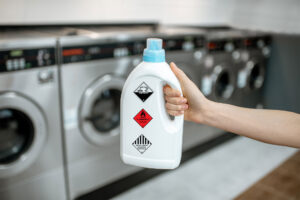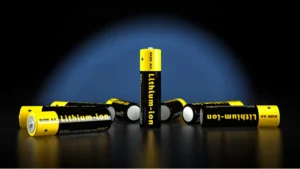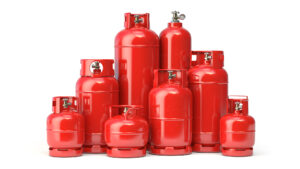Discover the Handling Risks of Liquid vs. Powdered Detergents
Detergents are essential products in households and industries, ensuring cleanliness and hygiene across a range of applications. However, when it comes to logistics, detergents—whether in liquid or powdered form—pose unique handling and safety challenges. Therefore, understanding the risks associated with each type is crucial for businesses and logistics providers responsible for transporting, storing, and delivering these products safely.
Let’s dive into the handling risks of liquid and powdered detergents and explore best practices for keeping them secure during transit and storage.
Dangerous Goods Classifications for Detergents
Class 3: Flammable Liquidsc
Some liquid detergents, especially industrial cleaning solutions, contain flammable solvents or alcohols, which classify them under Class 3. These detergents require specialized handling, packaging, and storage to prevent ignition during transport.
Class 8: Corrosive Substances
Detergents containing strong acids or alkalis (such as sodium hydroxide) fall under Class 8. These substances can cause severe burns on contact with skin or damage other materials if spilled. Many industrial detergents or cleaners designed to remove heavy grease and grime may be corrosive and require extra precautions.
Class 9: Miscellaneous Dangerous Goods
Some detergents contain environmentally hazardous substances, which may classify them under Class 9 if they pose a risk to aquatic life or ecosystems upon spillage. These are often detergents with certain biocides or other additives harmful to the environment.
Limited Quantities
Household or consumer-grade detergents with minimal hazardous components might not be fully classified as dangerous goods (DG). However, when shipped in bulk, they may qualify as “limited quantities” if the volume or concentration of certain ingredients meets specific thresholds. This requires careful labeling and handling but is less restrictive than full dangerous goods classification.
Non-Dangerous Goods
Many consumer detergents, especially those without harmful chemicals or flammable substances, are classified as non-dangerous goods. These products are relatively safe to handle and transport, provided they are packaged properly to avoid leaks or contamination.
Chemical and Physical Risks of Liquid Detergents
Liquid detergents contain concentrated cleaning agents that can pose several risks if not handled carefully. They are as follows:
Skin and Eye Irritation
The high concentration of surfactants, solvents, and sometimes enzymes in liquid detergents can cause skin and eye irritation. Direct contact with skin or accidental splashes to the eyes can lead to redness, itching, and in severe cases, burns.
Spill Hazards and Slip Risks
One of the most significant handling risks with liquid detergents is the potential for spills. Liquid detergents are prone to leakage, especially if containers are damaged or stored improperly. Spills not only waste products but also create slip hazards, which can be dangerous in busy warehouse or retail environments.
Inhalation Risks
Some liquid detergents, particularly those containing ammonia or bleach, can emit fumes that irritate the respiratory system. In poorly ventilated spaces, prolonged exposure to these fumes can cause respiratory discomfort or exacerbate conditions like asthma.
Flammability Risks
Certain liquid detergents contain solvents or alcohols, which can be flammable. In storage or transport, these products should be kept away from heat sources to minimize the risk of fire.
Reactivity with Other Chemicals
Liquid detergents can sometimes react dangerously with other cleaning agents. For example, combining bleach-based detergents with ammonia or acid-based cleaners can produce toxic chloramine gas, posing a serious risk to anyone exposed.
Chemical and Physical Risks of Powdered Detergents
Powdered detergents come with their unique handling risks that need to be managed effectively.
Dust Inhalation
One of the primary risks associated with powdered detergents is inhalation of dust particles. Fine detergent dust can become airborne during handling or transferring and may irritate the respiratory tract if inhaled. Long-term exposure to these particles may pose health risks, particularly in poorly ventilated environments.
Skin and Eye Contact
Though powdered detergents are generally less concentrated than liquids, direct contact with skin or eyes can still cause irritation. Some powdered detergents contain bleach or other chemicals that can lead to chemical burns if handled without protective gear.
Spill and Slipping Risks
Although not as prone to causing slips as liquids, powdered detergents can still create slipping hazards, especially on smooth surfaces when spilled. Spilled powder can also cause cross-contamination if it mixes with other products or materials in shared storage areas.
Reactivity with Moisture
Powdered detergents can react with moisture, leading to clumping and degradation of the product. If water enters the packaging, it may cause the detergent to harden and become less effective. In certain cases, exposure to moisture can even initiate a chemical reaction that produces heat, potentially posing a fire hazard.
Combustibility and Dust Explosions
In high enough concentrations, fine particles of powdered detergent can be combustible and may even lead to a dust explosion in an enclosed space. This risk is particularly relevant for storage and processing facilities where powdered detergent dust can accumulate and come into contact with an ignition source.
Best Practices in Handling and Transporting Detergents
When transporting detergents by air, the International Air Transport Association (IATA) has specific regulations and practices to ensure safety, given the potentially hazardous nature of some detergent products. The IATA’s Dangerous Goods Regulations (DGR) provide guidelines for identifying, packaging, labeling, and handling detergents that contain hazardous substances.
Here’s a brief overview of IATA transportation practices for detergents:
Classification and Identification
- Not all detergents are classified as hazardous, but some may fall under dangerous goods classifications due to specific chemical properties.
- Detergents containing flammable, corrosive, or environmentally hazardous components must be identified and classified accordingly, commonly under Class 3 (flammable liquids), Class 8 (corrosives), or Class 9 (miscellaneous hazardous materials).
- Proper identification includes assigning the correct UN number (e.g., UN1760 for certain liquid corrosive materials) and classification to guide packaging and labeling requirements.
Packaging Requirements
- Detergents classified as dangerous goods must be packaged in UN-approved containers that are robust enough to withstand the conditions of air travel.
- Packaging must prevent leakage, even under rough handling, and must comply with IATA standards for primary and secondary containment.
- For non-dangerous detergents, standard secure packaging that prevents leakage and ensures product integrity during transit may be sufficient.
Labeling and Marking
- IATA requires that all dangerous goods be properly labeled with hazard labels (such as flammable, corrosive, or environmentally hazardous labels) and handling labels.
- Each package must display the UN number and include the proper shipping name of the detergent product, along with any other relevant hazard labels.
- Non-hazardous detergents still need clear labeling to indicate contents, especially if shipped in bulk, to avoid misclassification and ensure proper handling.
Documentation
- A Shipper’s Declaration for Dangerous Goods is required for hazardous detergents. This document includes details such as the product’s classification, quantity, packaging, and emergency contact information.
- Non-dangerous detergents do not require a Shipper’s Declaration but should have a Material Safety Data Sheet (MSDS) on hand to provide handling information and ensure compliance with international air transport regulations.
Quantity Limitations
- IATA sets specific quantity limits for transporting dangerous goods, including detergents, in passenger and cargo aircraft. These limits help to mitigate risks and vary depending on the substance’s hazard classification and packaging group.
- For example, dangerous detergents classified as limited quantities (small amounts meeting specific criteria) may have relaxed requirements, provided they’re appropriately labeled and packaged.
Special Handling Instructions
- Some detergents, especially those in bulk shipments, may require special handling due to risks associated with leaks or contamination. Airlines and ground staff must follow handling instructions to ensure safe loading and unloading.
- Proper segregation from incompatible goods is essential, particularly if the detergent is corrosive or reactive.
Training and Compliance
- Personnel involved in the transport of dangerous goods, including certain detergents, must complete IATA-certified training to understand safety and handling requirements. Your logistics partner in the UAE must also be certified by the General Civil Aviation Authority (GCAA) when transporting the goods via air.
- Compliance with IATA regulations is mandatory, and airlines often conduct inspections to ensure adherence to IATA DGR to minimize risks.
TFI: Your Trusted Partner in Handling and Transporting Detergents
Handling liquid and powdered detergents each comes with unique risks due to their chemical and physical properties. Liquid detergents pose spill and fume hazards, while powdered detergents present risks related to dust inhalation and moisture reactivity. Thus, implementing proper storage, handling, transportation, and safety measures can minimize risks, ensuring the safety of both handlers and the environment.
At TFI, we understand how risks related to detergents can take a toll on your business, people, and the environment. This is why we offer solutions such as packing, air freight forwarding, and customs clearance that comply with IATA’s stringent regulations. Licensed by the General Civil Aviation Authority (GCAA), you can rely on our regulatory compliance, access to global aviation networks, and operational excellence.
Contact our DG-certified specialists today to discuss your requirements!




